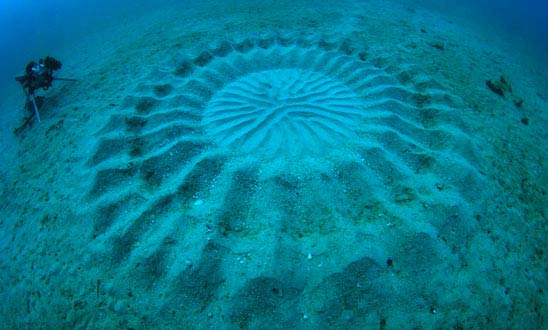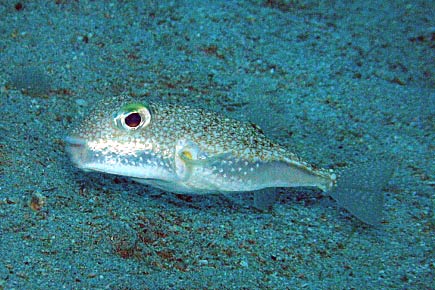The same day that I posted the previous article gushing over the perfection of male-constructed tilapia nests on Maui, a blog article on a Japanese pufferfish nest discovery was posted and picked up by the news media.
http://www.spoon-tamago.com/2012/09/18/deep-sea-mystery-circle-love-story/
Since then it has been re-blogged and re-reported hundreds of times. The story is so popular because it appeals not only to fish scientists and divers, but to artists as well, and if you’ve seen the photos you know why. This nest put the modest tilapia fathers’ nests (in mud) to shame.

Nest created in sand by male pufferfish in Amami Oshima, Japan (Discovery and photo by Youji Ookata).
Not only was the pufferfish nest huge (6.5 feet across) taking hours to construct, but it brought to mind the concentric design of a mandala – the circular figure representing the entire universe in Hindu and Buddhist symbolism. For all its detail and perfection, this nest could symbolize this very thing.

Photo by Youji Ookata. This pufferfish appears to be a member of the genus Torquigener, but its species name is unknown at this time.
Intriguing questions arise from this discovery by Youji Ookata, a passionate Japanese underwater photographer who has spent over 50 years exploring the ocean. In only 80 feet of water, how did such a creation go unreported until now? What species of fish is making this nest? Though not identified in the photos, the puffer appears to be in the genus Torquigener.
I queried Dr. Jack Randall who in turn asked a Japanese colleague who works on pufferfish about the identity of this puffer. His colleague reported seeing the spawning behavior himself and confirmed that he thought it was a Torquigener, but he was not familiar with the species. He intends to revisit the island during the next spawning season in hopes of making an identification.
What makes this even more exciting is that we have two species of Torquigener right here in Hawaii: T. florealis which is also found in Japan, and T. randalli (named in honor of Dr. Jack Randall) which is endemic.

Torquigener florealis (Photo by Keoki Stender, left) and Torquigener randalli (Photo by P. Fiene, right)
It seems to me that if tilapia of different genera (and even more distant relatives of theirs such as sunfish) all make the same type of circular nest, then members of the Torquigener genus and its relatives might make nests similar to the Japanese puffer.
If the nesting season is only during a certain moon phase, occurs only once a year, and/or is in deeper water than recreational divers typically dive, perhaps we have missed a similar sight here in Hawaii. Has anyone seen either of these puffers nest or spawn here in Hawaii?
If you can read Japanese, here is Youji Ookata’s original post: http://ookatayouji.amaminchu.com/archives/2012/09/post_459.html

Comments 5
Wow!
Can’t say I have ever seen these fish spawn or nest. 80 feet isn’t that deep and as many of these fish as we see out there it would seem likely that someone would have seen one of these nests by now. Do you, or Randall, have any idea when the spawning takes place? If you ever get to witness this, you better let me know and take me to see it!
Author
Hi Mike. He didn’t ask his colleague but I will ask him to try and find out. I think it must just be in deeper water than we normally are….. We better get busy! 🙂
I’ve never seen a nest, but I did run into a large school of juvenile T. randalli at about 80′ in Haleiwa Trench one day. They went into a ball as soon as we approached. Unfortunately, I was low on air and had to go before I could spend too much time with the young fish. Strange fish.
This is incredible. I agree with Mike, it would seem likely that someone would have seen one of these by now if any of our puffers did this. Could Hawaiian puffers just be too lazy and laid back? I don’t like to stereotype but I think that Japan, over all, has a somewhat more intense work ethic and an aesthetic sense that is just slightly superior. : )
Author
I agree about Japanese artistry, Christy! But we haven’t seen even a simple Torquigener nest here. So, we must have missed it so far just like they did in Japan. I don’t think it is surprising. How much time do we spend in open sand at 80+ feet? We only see these puffers a handful of times a year in the course of their daily lives, so if they go a little deeper to nest, or nesting only lasts a few days in a single month, we could easily be missing it. Japan isn’t lacking for divers, so if they are just discovering it……… 🙂